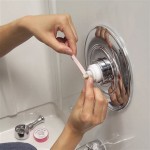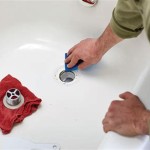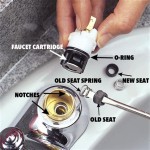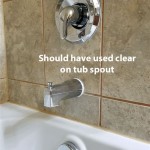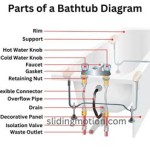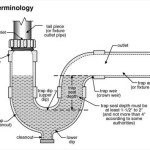How to Clean Bathtub Overflow Plate: A Comprehensive Guide
The bathtub overflow plate serves a critical function in preventing water from spilling over the tub’s edge, directing excess water down the drain. While essential, this component often gets overlooked during regular cleaning routines. Over time, it can accumulate soap scum, hair, mildew, and other debris, leading to unpleasant odors, unsightly stains, and potentially even drainage problems. Regular cleaning of the overflow plate is crucial for maintaining a hygienic and functional bathroom environment. This article provides a detailed guide on how to effectively clean a bathtub overflow plate, covering various methods and preventative measures.
Understanding the Overflow Plate and Its Significance
Before delving into the cleaning process, it is important to understand the anatomy and function of the overflow plate. The overflow plate is typically a small, circular or rectangular plate located near the top of the bathtub, usually beneath the faucet. It is connected to a pipe, known as the overflow pipe, which leads directly to the main drain. This system is designed to prevent flooding if the water level in the bathtub rises too high. The overflow plate often incorporates a mechanism for operating the bathtub drain stopper. This mechanism can vary, ranging from a simple lever to a more complex linkage system. Understanding the specific type of mechanism can be helpful when disassembling and cleaning the plate.
The buildup of debris within the overflow mechanism can lead to several problems. First, it can impede the proper draining of excess water, potentially causing minor flooding issues. Second, the accumulated grime can harbor bacteria and mold, leading to unpleasant odors that permeate the bathroom. Third, the debris can interfere with the smooth operation of the drain stopper, making it difficult to open or close the drain effectively. Consequently, neglecting the overflow plate can result in a less enjoyable and potentially unsanitary bathing experience.
Regular cleaning of the overflow plate is not merely a cosmetic concern. It is a vital aspect of maintaining the bathtub's functionality and preventing plumbing issues. By removing the buildup of grime and debris, one ensures the efficient operation of the overflow system and prevents the accumulation of harmful bacteria and mold.
Methods for Cleaning a Bathtub Overflow Plate
Several methods can be employed to clean a bathtub overflow plate, ranging from simple surface cleaning to more thorough disassembly and cleaning. The most appropriate method will depend on the severity of the buildup and the type of overflow plate mechanism.
Surface Cleaning with Household Solutions
For light buildup, a simple surface cleaning may suffice. This method involves using common household cleaning solutions and basic tools. The following steps outline the process:
- Gather Supplies: Collect the following items: a spray bottle, all-purpose bathroom cleaner, white vinegar, baking soda, a toothbrush or small scrub brush, cleaning cloths, and rubber gloves.
- Prepare the Cleaning Solution: In the spray bottle, mix equal parts white vinegar and water. This solution acts as a natural disinfectant and helps to dissolve soap scum and mineral deposits. Alternatively, use a commercially available all-purpose bathroom cleaner.
- Spray and Soak: Generously spray the overflow plate and surrounding area with the cleaning solution. Allow the solution to sit for approximately 15-20 minutes to loosen the grime. For stubborn stains, create a paste of baking soda and water and apply it to the affected areas before spraying with the vinegar solution. The combination of baking soda and vinegar creates a fizzing action that helps to lift away dirt and grime.
- Scrub the Surface: Using the toothbrush or small scrub brush, scrub the surface of the overflow plate, paying close attention to any crevices or edges where dirt tends to accumulate. Apply moderate pressure to remove stubborn stains and buildup.
- Rinse Thoroughly: Rinse the area thoroughly with clean water to remove all traces of the cleaning solution and loosened debris. Ensure that the water flows freely through the overflow drain.
- Dry and Polish: Use a clean cleaning cloth to dry the overflow plate and surrounding area. Polish the plate to restore its shine and remove any remaining water spots.
This method is effective for removing light to moderate buildup and can be performed regularly as part of a routine bathroom cleaning schedule. However, for more significant buildup or if the overflow mechanism is clogged, a more thorough cleaning method may be required.
Disassembling and Cleaning the Overflow Plate
For more thorough cleaning, disassembling the overflow plate is recommended. This allows access to the internal components of the overflow mechanism, enabling the removal of stubborn debris and ensuring optimal function. The following steps outline the process:
- Gather Supplies: Collect the following items: a screwdriver (appropriate type and size for the screws on the overflow plate), pliers (if needed to loosen stubborn screws), a container to hold screws and small parts, all-purpose bathroom cleaner, white vinegar, baking soda, a toothbrush or small scrub brush, cleaning cloths, rubber gloves, and a small wire brush (optional, for cleaning internal components).
- Turn off the Water Supply (Optional): While not strictly necessary for cleaning the overflow plate, turning off the water supply to the faucet can provide an extra layer of safety and prevent accidental water flow during the disassembly process. Usually there is no connection between the faucet and the overflow plate's drain.
- Remove the Overflow Plate: Using the screwdriver, carefully remove the screws that secure the overflow plate to the bathtub. Place the screws in the container to prevent them from being lost. Once the screws are removed, gently pull the overflow plate away from the bathtub. Be careful not to force it, as this could damage the plate or the connected mechanism.
- Disassemble the Overflow Mechanism: Depending on the type of overflow mechanism, there may be additional components that need to be disassembled. Refer to the manufacturer's instructions or consult online resources for specific instructions on disassembling the mechanism. Typically, this involves disconnecting linkages or removing additional screws. Carefully observe the order in which the components are assembled to ensure proper reassembly.
- Clean the Components Thoroughly: Once the overflow plate and mechanism are disassembled, clean each component thoroughly. Use the all-purpose bathroom cleaner, white vinegar, and baking soda to remove soap scum, hair, and other debris. Use the toothbrush or small scrub brush to clean hard-to-reach areas. For stubborn buildup, soak the components in a solution of white vinegar and water for several hours or overnight. A small wire brush can be helpful for cleaning internal components and removing rust or corrosion.
- Rinse and Dry: Rinse all components thoroughly with clean water to remove all traces of the cleaning solution and loosened debris. Allow the components to air dry completely before reassembling.
- Reassemble the Overflow Mechanism: Carefully reassemble the overflow mechanism, following the reverse order of disassembly. Ensure that all components are properly aligned and securely connected. Refer to the manufacturer's instructions or consult online resources if needed.
- Reattach the Overflow Plate: Reattach the overflow plate to the bathtub using the screws that were removed earlier. Tighten the screws securely, but be careful not to overtighten them, as this could damage the plate or the bathtub.
- Test the Drain Stopper: Once the overflow plate is reattached, test the drain stopper to ensure that it is functioning properly. Open and close the drain several times to verify that it is sealing and releasing correctly.
This method provides a more thorough cleaning and is recommended for overflow plates with significant buildup or when the drain stopper is not functioning properly. It requires more time and effort but can significantly improve the functionality and hygiene of the bathtub.
Using Specialized Cleaning Tools
In addition to household cleaning solutions and basic tools, specialized cleaning tools can be used to clean bathtub overflow plates, particularly for removing stubborn clogs and debris from the overflow pipe. A popular tool is the drain snake or auger.
- Drain Snake/Auger: A drain snake is a flexible tool designed to reach deep into drains and break up or remove clogs. Insert the drain snake into the overflow pipe and gently rotate it while pushing it further into the pipe. If resistance is encountered, continue rotating the snake to break up the clog. Once the clog is broken up or removed, pull the snake out of the pipe and rinse it thoroughly.
Using a drain snake can be effective for removing hair, soap scum, and other debris that may be clogging the overflow pipe. However, it is important to use caution when using a drain snake to avoid damaging the pipe or the overflow mechanism.
Preventative Measures for Maintaining a Clean Overflow Plate
Preventing buildup in the overflow plate is just as important as cleaning it. Implementing preventative measures can significantly reduce the frequency and intensity of cleaning required. Here are some effective preventative measures:
Regular Rinsing
After each bath or shower, rinse the overflow plate and surrounding area with clean water to remove any soap scum or hair that may have accumulated. This simple step can prevent the buildup of debris and make cleaning much easier.
Using a Hair Catcher
A hair catcher placed in the bathtub drain can significantly reduce the amount of hair that enters the overflow pipe and contributes to buildup. Hair catchers are inexpensive and easy to install and can save a significant amount of time and effort in the long run.
Regular Cleaning Schedule
Establish a regular cleaning schedule for the overflow plate and stick to it. Depending on the frequency of use, cleaning the overflow plate every one to three months can help prevent significant buildup. Include this task in the overall bathroom cleaning routine.
Avoiding Harsh Chemicals
While harsh chemicals may seem like a quick solution for cleaning the overflow plate, they can actually damage the plate and the connected mechanism over time. Avoid using harsh chemicals such as bleach or strong acids, as they can corrode the metal components and damage the plastic parts. Opt for gentler cleaning solutions such as white vinegar and baking soda, which are effective at removing buildup without causing damage.
By implementing these preventative measures, one can significantly reduce the buildup of debris in the bathtub overflow plate and maintain a clean and functional bathroom environment. Regular maintenance and preventative care are key to extending the lifespan of the overflow system and preventing costly repairs.

4 Ways To Clean A Bathtub Drain Wikihow

4 Ways To Clean A Bathtub Drain Wikihow

Diy Unclog Trip Lever Bathtub Drain Without Chemical

4 Ways To Clean A Bathtub Drain Wikihow

How To Unclog Bathtub Drain Pipes Save 200 In Two Minutes

5 Easy Ways To Unclog Bathtub Drain

How To Unclog A Bathtub Drain Without Chemicals

Bathtub How Can I Remove A Stuck Bath Stopper Assembly Home Improvement Stack Exchange

What Is A Bathtub Overflow Drain 2025 Guide With Examples And Photos Badeloft

How To Install A New Bathtub Overflow Plate Assembly
Related Posts

